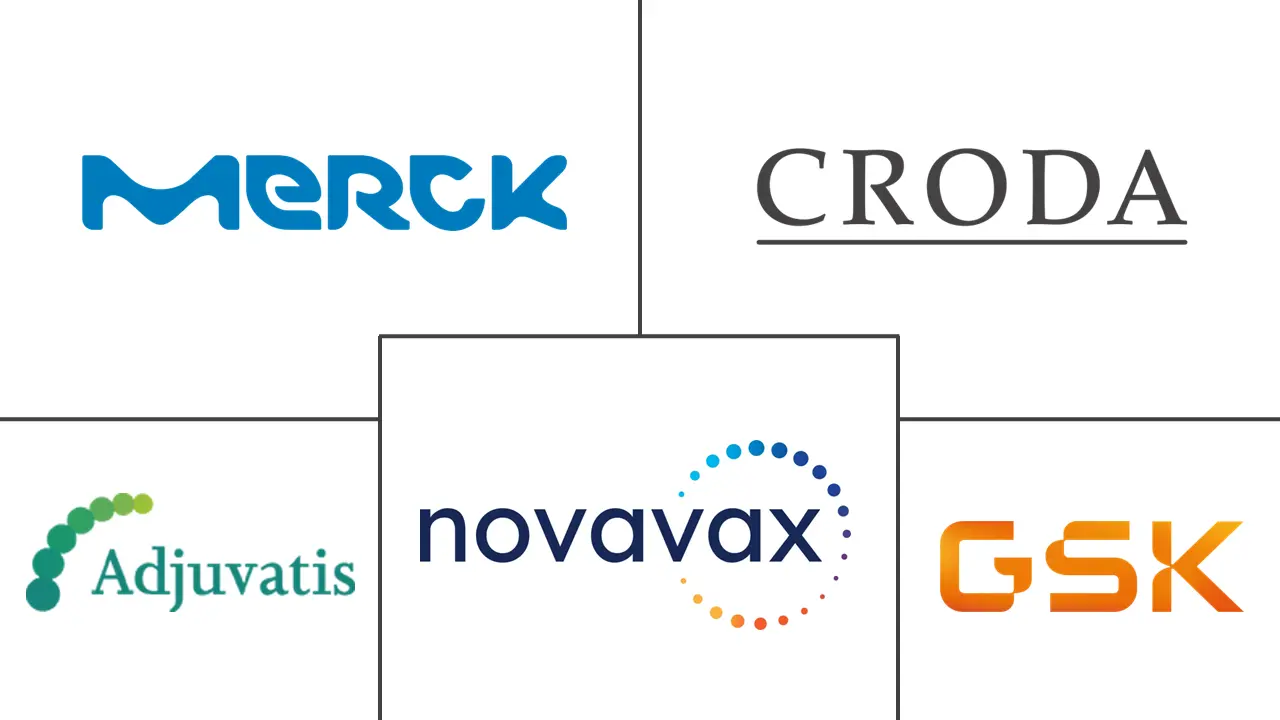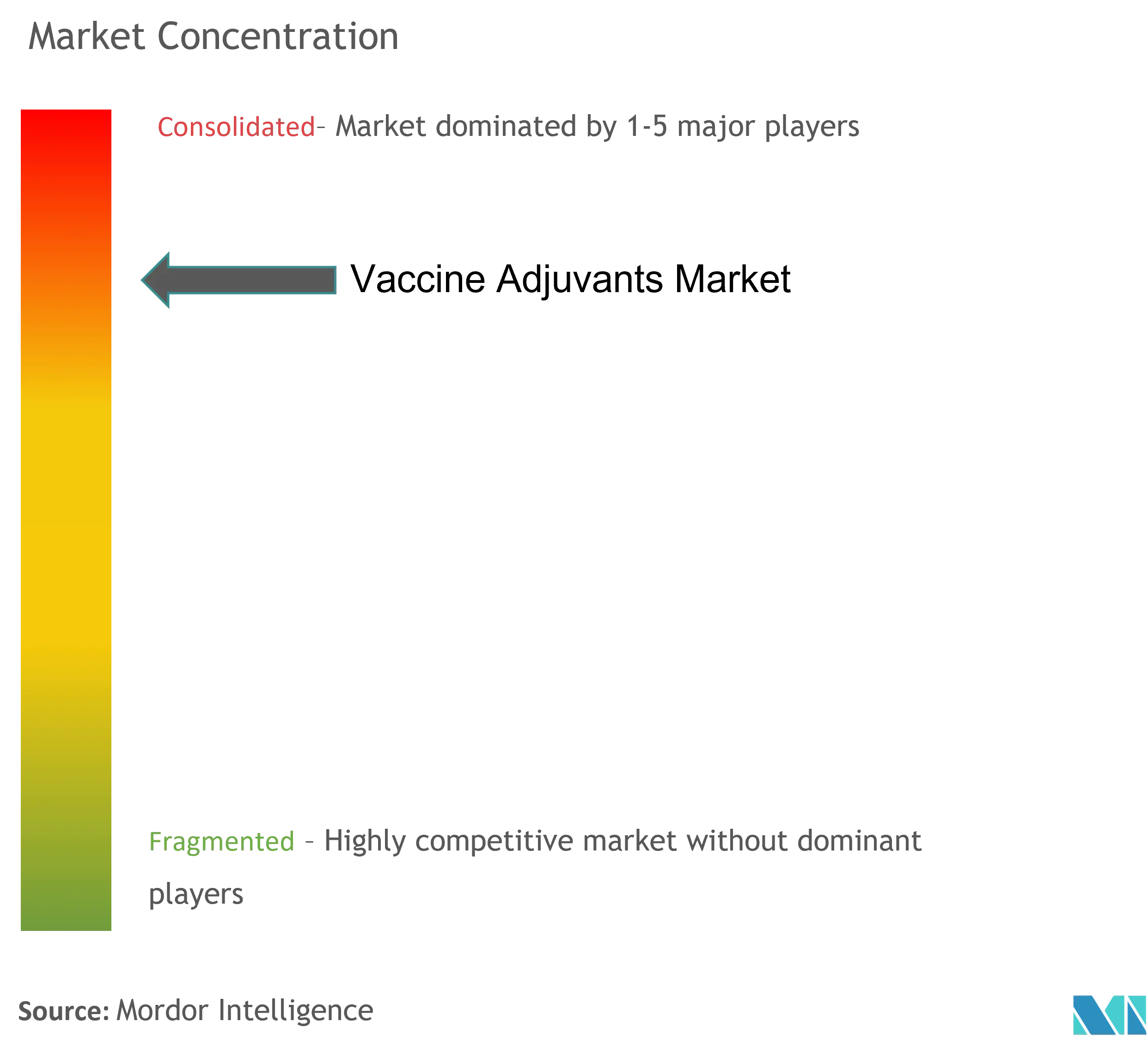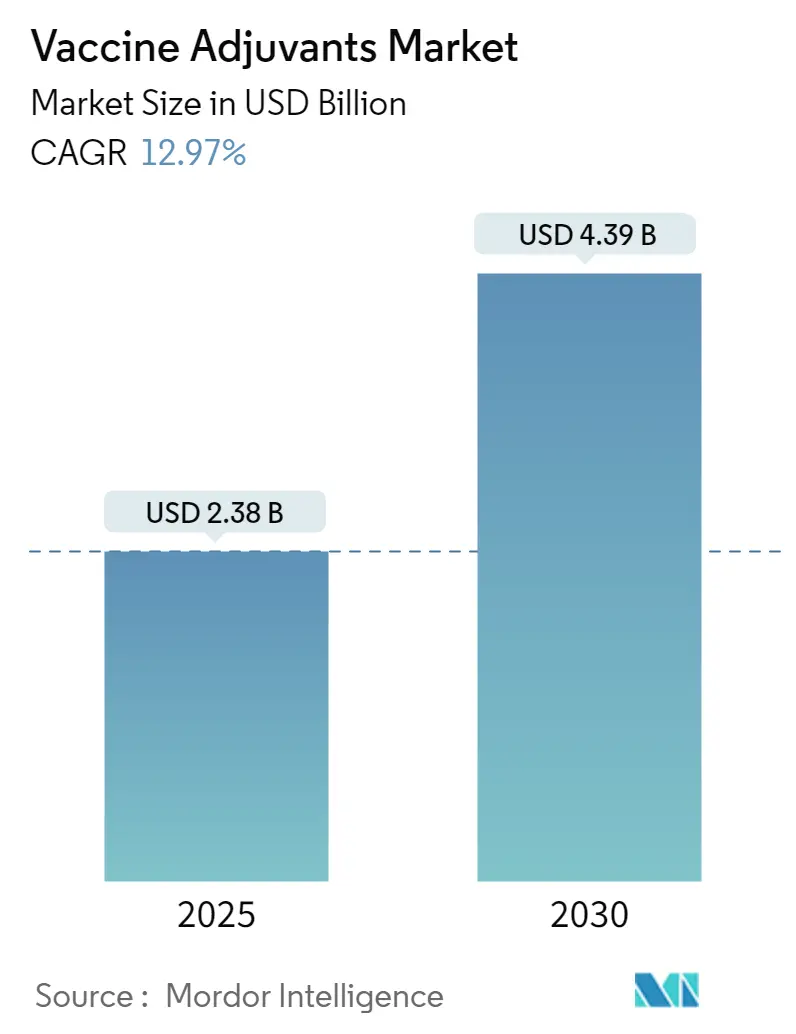
Vaccine Adjuvants Market Analysis
The Vaccine Adjuvants Market size is estimated at USD 2.38 billion in 2025, and is expected to reach USD 4.39 billion by 2030, at a CAGR of 12.97% during the forecast period (2025-2030).
The COVID-19 pandemic had a significant impact on the market. Adding appropriate adjuvants to COVID-19 vaccines substantially reduced the number of required doses and improved efficacy or cross-neutralizing protection. For instance, according to an article published by Viruses in February 2022, various vaccine launches for COVID-19 had shown decreased protection against variants of concern (VOCs) of SARS-CoV-2, and there were increasing numbers of breakthrough infections with VOCs in the vaccinated population. This called for the stepped-up development of Immunostimulatory Adjuvants that induce effective and durable protective immunity against SARS-CoV-2 and its emerging variants.
Thus, COVID-19 impacted the Vaccine Adjuvants Market positively. As per the above source, adjuvants used with SARS-CoV-2 vaccine candidates were Aluminum Based Vaccine Adjuvants, STING agonist-based adjuvants, oil-in-water emulsion adjuvants, TLR agonist adjuvants, and a few more. Therefore, due to the advantage and development of new Vaccine Adjuvants, the demand also increased during the COVID-19 pandemic and is expected to grow in the coming period.
The factors that promote the growth of the Adjuvant Market include unmet demand for specific vaccines, increasing government vaccination recommendations, and increasing use of recombinant subunit and synthetic vaccines. For instance, according to the data published by the WHO in the Global Tuberculosis Report 2021, most of the tuberculosis cases were found in the WHO regions of Southeast Asia (43%), Africa (25%), and Western Pacific (18%), and lesser numbers of tuberculosis cases were found in Eastern Mediterranean (8.3%), the Americas (3.0%), and Europe (2.3%). Additionally, according to the WHO data published in 2021, Sub-Saharan Africa likely continues to endure the burden of malaria, accounting for approximately 95% of all cases and 96% of all deaths. Thus, rising cases of infectious diseases are expected to increase the demand for vaccines, resulting in the high growth of the Vaccine Adjuvant Market.
Furthermore, according to the CDC update in January 2021, in order to prevent occupational exposure to the Ebola virus species Zaire Ebolavirus, the Advisory Committee on Immunization Practices (ACIP) recommends preexposure vaccination with Ervebo for adults in the U.S. population older than 18 years of age who are at more risk. This is because they are responding to the Ebola virus disease outbreak (EVD). Therefore, increasing government vaccination recommendations is expected to drive market growth.
Vaccine Adjuvant Manufacturers are introducing new, more sophisticated Vaccine Adjuvants, which are anticipated to significantly support the market's growth. For instance, in December 2022, Evonik launched PhytoSquene, a non-animal-derived squalene suitable for vaccines and other pharmaceutical applications. PhytoSquene is an amaranth oil-derived squalene on the market for use in adjuvants in parenteral dosage forms. It meets the demand for a secure commercial supply of non-animal-derived squalene. Such instances are expected to drive the Vaccine Adjuvant Market growth over the forecast period.
Thus, these factors mentioned above, such as unmet demand for specific vaccines, increasing government vaccination recommendations, and increasing use of recombinant subunit and synthetic vaccines, are anticipated to boost the market's growth over the forecast period. However, side effects, the high toxicity of adjuvants, and the high R&D cost of developing a new adjuvant are expected to hinder the market's growth.
Vaccine Adjuvants Market Trends
Carbohydrate Adjuvants Segment Expected to Witness a Significant CAGR Over The Forecast Period
Carbohydrate adjuvants are safe and biocompatible compounds usable as sustained delivery systems and as Immunomodulators of ongoing humoral and cellular immune responses, being especially suitable for the development of vaccines against intracellular pathogens where alum is useless.
The carbohydrate adjuvants segment is expected to grow significantly over the forecast period due to its wide range and use in human vaccines. For instance, as per an article published by Nature Reviews Chemistry in January 2021, carbohydrates play crucial roles in the immune system function and the stimulation of the immune response that can be exploited by the chemistry community. Carbohydrates possess many beneficial properties, such as high biocompatibility and tolerability and a strong safety profile. A variety of natural carbohydrate structures, particularly MPLA and QS-21, have been clinically evaluated as adjuvants and are part of licensed Adjuvant Systems (AS) in human vaccines against HPV (AS04), herpes zoster, and malaria (AS01). Due to these characteristics, the segmental market is expected to grow.
Additionally, in October 2022, the phase 1 test of the novel low-dose influenza vaccine was developed under the INDIGO project, directed by AIGHD. This vaccine combines a new adjuvant, a component used in several vaccines to induce a stronger immune response, with a licensed influenza vaccine at 1/5th of a dose. Such an initiative is expected to drive segmental growth.
Furthermore, a few key Vaccine Adjuvant Companies are developing novel products and technologies to compete with existing products, while others are acquiring and partnering with other companies trending in the market. For instance, in March 2021, Oragenics, Inc. entered into a material transfer agreement with Biodextris Inc. for the use of three intranasal mucosal adjuvants in the company's Terra CoV-2 vaccine against COVID-19. Adjuvants are added to vaccines to enhance their immunogenicity. BDX100, BDX300, and BDX301 are proteosome-based adjuvants comprised of proteins and lipopolysaccharides with improved attributes, including enhanced immune response, manufacturing efficiency, and the benefits of intranasal vaccine administration. Such development is expected to drive the segmental growth.
Thus, owing to the aforementioned factors, such as a wide variety of vaccines, initiatives in the development of vaccines, and strategic development by key players, the carbohydrate adjuvants segment is expected to register healthy growth over the forecast period.
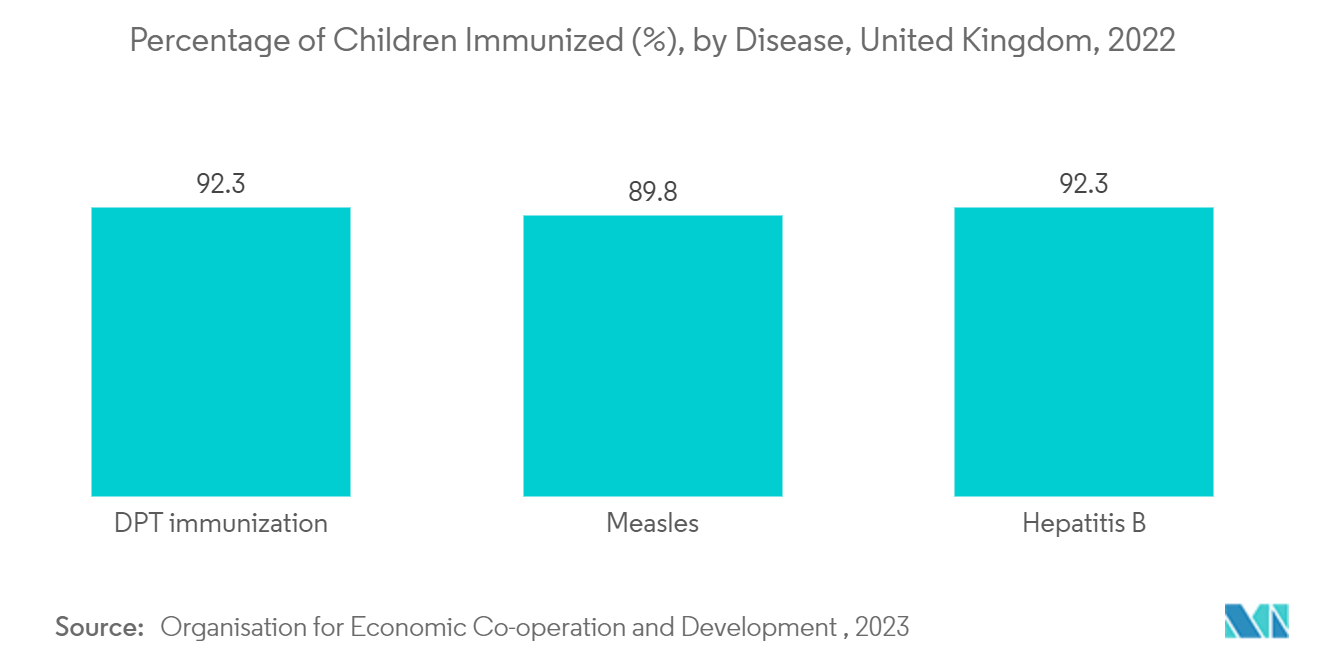
North America Expected to Hold a Significant Market Share Over the Forecast Period
North America is expected to observe significant growth in the market studied during the forecast period. The main factors driving the growth of the Vaccine Adjuvant Market in the North American region are the presence of key market players, the availability of advanced technology, and the growing government initiatives to launch various awareness campaigns to increase vaccination. For instance, in January 2021, the United States Department of Health and Human Services (HHS) launched the HPV VAX NOW campaign to increase human papillomavirus (HPV) vaccination rates among young adults ages 18-26. Also, in August 2022, the Government of Canada published the Canadian Immunization Guide Chapter on Influenza and Statement on Seasonal Influenza Vaccine for 2022-2023, which provides updated recommendations regarding the use of seasonal influenza vaccines in Canada. Hence, such an initiative from the government is expected to drive market growth.
Additionally, various strategies such as product approval, launches, agreements, and developments help the market to grow over the study period. For instance, in November 2022, GSK plc reported that the US FDA accepted a Biologics License Application (BLA) and granted priority review for its respiratory syncytial virus (RSV) older adult vaccine candidate. The US FDA grants priority review to applications for vaccines that, if approved, would offer significant improvements in the safety or effectiveness of the treatment or prevention of serious conditions when compared to standard applications.
Therefore, owing to the aforementioned factors, such as several immunization programs, government and non-government initiatives, and increased demand for combined vaccines, the Vaccine Adjuvants Market is expected to augment growth over the analysis period.
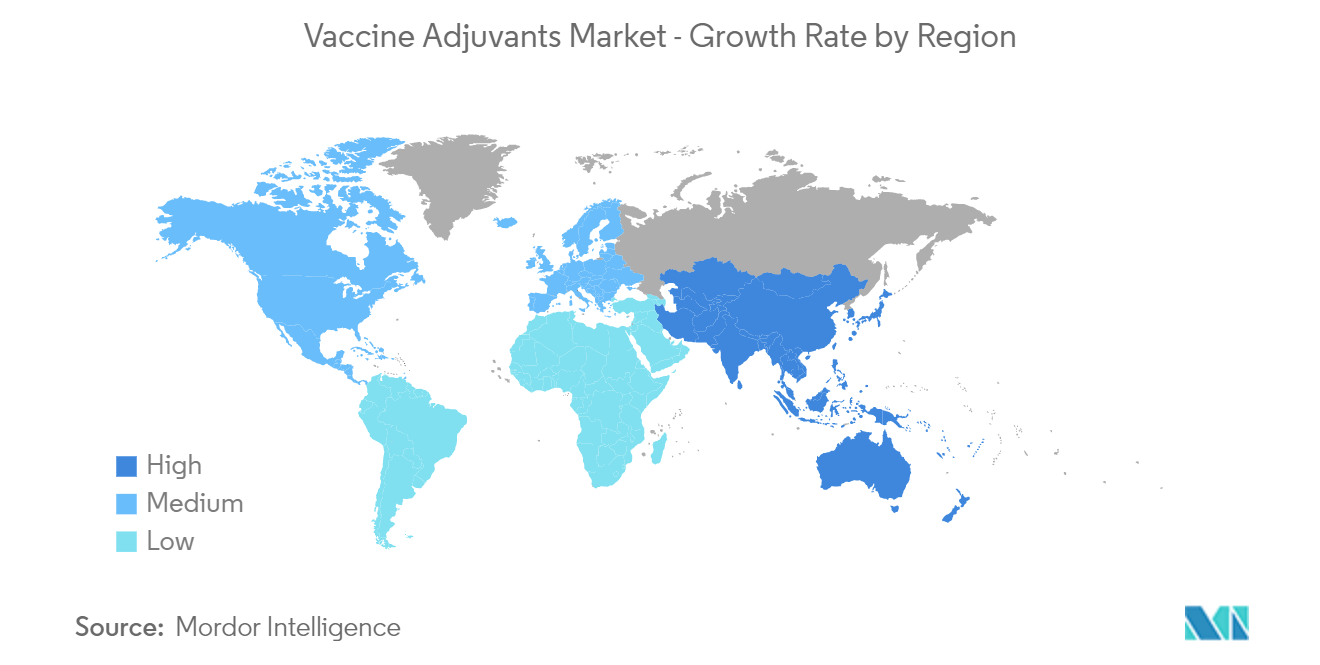
Vaccine Adjuvants Industry Overview
The Vaccine Adjuvants Market is consolidated in nature due to the presence of a few Vaccine Adjuvant Manufacturers operating globally and regionally. The strategic initiatives taken by various governments to improve immunization and research and development for vaccine development by market players are propelling the market growth. The companies in the market include Adjuvatis, GlaxoSmithKline PLC, Croda International PLC, Merck KGaA, and Novavax Inc., among others.
Vaccine Adjuvants Market Leaders
-
Adjuvatis
-
Merck KGaA
-
GlaxoSmithKline plc
-
Novavax Inc.
-
Croda International plc
- *Disclaimer: Major Players sorted in no particular order
Vaccine Adjuvants Market News
- January 2023: Elicio Therapeutics engineers lymph node-targeted adjuvants and vaccines for an array of aggressive cancers and infectious diseases and entered into a definitive merger agreement with Angion Biomedica Corp to focus on advancing Elicio's proprietary lymph node-targeting Amphiphile (AMP) technology to develop immunotherapies, with a focus on ELI-002, a therapeutic cancer vaccine targeting mKRAS-driven tumors.
- November 2022: Hubro Therapeutics AS acquired GM-CSF vaccine adjuvant from Targovax ASA in an asset purchase agreement for a cash payment of NOK10 million. Hubro continues the development of GM-CSF as an adjuvant for use with its pipeline of novel cancer vaccines.
Vaccine Adjuvants Industry Segmentation
As per the scope of the report, an adjuvant is a pharmacological or immunological agent that helps synergize and direct the adaptive immune response to a vaccine agent. Adjuvants are compounds that improve the body's immunogenic reaction against antigens. Therefore, adjuvants are majorly added to vaccines to augment their capability to ensure long-term protection and safety against any infection.
The vaccine adjuvants market is segmented by product type (mineral salt-based adjuvants, tensoactive adjuvants, adjuvant emulsions, liposome adjuvants, carbohydrate adjuvants, bacteria-derived adjuvants, virus-like particles (vlp), and other product types), usage type (active immunostimulants, carriers, and vehicle adjuvants), disease type ( infectious disease and cancer), application (research applications and commercial applications), and geography (North America, Europe, Asia-Pacific, Middle East and Africa, and South America). The market report also covers the estimated market sizes and trends for 17 countries across major regions globally. The report offers the value (in USD) for the above segments.
| By Product Type | Mineral Salt-based Adjuvant | ||
| Tensoactive Adjuvants | |||
| Adjuvant Emulsions | |||
| Liposome Adjuvants | |||
| Carbohydrate Adjuvants | |||
| Bacteria-derived Adjuvants | |||
| Virus-like Particles (VLP) | |||
| Other Product Types | |||
| By Usage Type | Active Immunostimulants | ||
| Carriers | |||
| Vehicle Adjuvants | |||
| By Disease Type | Infectious Disease | ||
| Cancer | |||
| By Application | Research Applications | ||
| Commercial Applications | |||
| Geography | North America | United States | |
| Canada | |||
| Mexico | |||
| Europe | Germany | ||
| United Kingdom | |||
| France | |||
| Italy | |||
| Spain | |||
| Rest of Europe | |||
| Asia-Pacific | China | ||
| Japan | |||
| India | |||
| Australia | |||
| South Korea | |||
| Rest of Asia-Pacific | |||
| Middle East and Africa | GCC | ||
| South Africa | |||
| Rest of Middle East and Africa | |||
| South America | Brazil | ||
| Argentina | |||
| Rest of South America | |||
Vaccine Adjuvants Market Research FAQs
How big is the Vaccine Adjuvants Market?
The Vaccine Adjuvants Market size is expected to reach USD 2.38 billion in 2025 and grow at a CAGR of 12.97% to reach USD 4.39 billion by 2030.
What is the current Vaccine Adjuvants Market size?
In 2025, the Vaccine Adjuvants Market size is expected to reach USD 2.38 billion.
Who are the key players in Vaccine Adjuvants Market?
Adjuvatis, Merck KGaA, GlaxoSmithKline plc, Novavax Inc. and Croda International plc are the major companies operating in the Vaccine Adjuvants Market.
Which is the fastest growing region in Vaccine Adjuvants Market?
Asia-Pacific is estimated to grow at the highest CAGR over the forecast period (2025-2030).
Which region has the biggest share in Vaccine Adjuvants Market?
In 2025, the North America accounts for the largest market share in Vaccine Adjuvants Market.
What years does this Vaccine Adjuvants Market cover, and what was the market size in 2024?
In 2024, the Vaccine Adjuvants Market size was estimated at USD 2.07 billion. The report covers the Vaccine Adjuvants Market historical market size for years: 2019, 2020, 2021, 2022, 2023 and 2024. The report also forecasts the Vaccine Adjuvants Market size for years: 2025, 2026, 2027, 2028, 2029 and 2030.
Our Best Selling Reports
Vaccine Adjuvants Industry Report
Statistics for the 2025 Vaccine Adjuvants market share, size and revenue growth rate, created by Mordor Intelligence™ Industry Reports. Vaccine Adjuvants analysis includes a market forecast outlook for 2025 to 2030 and historical overview. Get a sample of this industry analysis as a free report PDF download.

